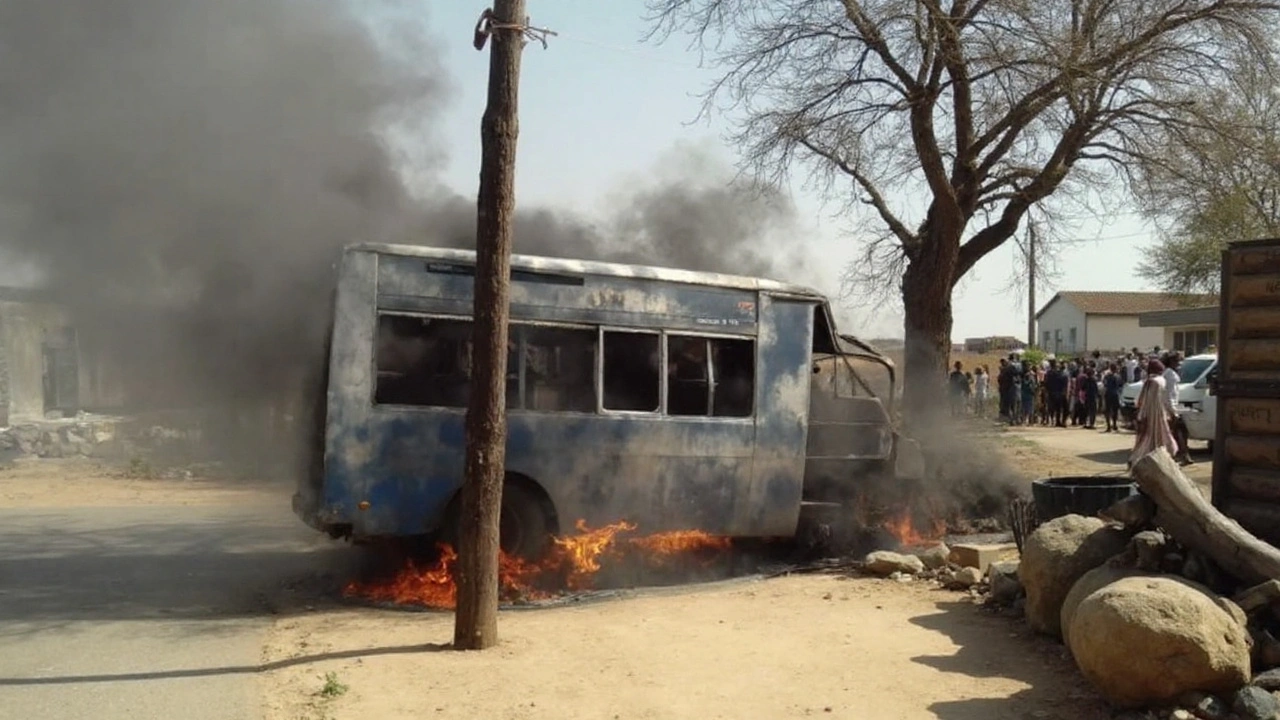Most daily commuters in South Africa get to work and back in a minibus taxi. That makes what happens in this industry a public safety issue, not a niche dispute. This week, SANTACO tried to draw a line after the killing of an e-hailing driver at Maponya Mall in Soweto, promising a zero-tolerance stance on violence involving its members.
Announcing the move in Johannesburg, council president Motlabane Tsebe said any operator, driver, or official linked to violent conduct will be shown the door. Expulsion from the association will be immediate, he said, with cases handed to the police. The council is assisting the victim’s family and has opened a probe into the Soweto attack along with other recent incidents.
A public promise after a killing
The Soweto case has reignited anger over intimidation in the transport sector and shone a light on long-simmering friction between traditional taxi services and e-hailing platforms such as Uber and Bolt. In parallel, videos circulating online show men in taxi-branded clothing forcing people out of private cars and telling them to use minibus taxis instead. The images cut straight to the heart of the trust problem: commuters want to choose their ride without fear.
Tsebe pushed back against claims that taxi associations are waging an organised campaign against e-hailing. He said members live in the same communities they serve and cannot dictate how people travel. The council’s message this time was blunt: anyone found to be intimidating passengers or attacking rivals will be expelled and reported to authorities.
That stance matters. The taxi sector carries the bulk of South Africa’s commuters, often where buses and trains don’t reach or aren’t reliable. But the industry has also accumulated baggage: unregulated routes in some areas, allegations of corruption, unlicensed drivers, and turf disputes that sometimes turn violent. Each headline scares commuters and drains confidence from a system millions depend on.
The tension with e-hailing is partly about money and space. E-hailing cars pick up where people are, often near taxi ranks and malls that taxi associations view as their trading ground. Drivers from both sides complain about harassment, while shoppers and workers get caught in the middle. When a confrontation ends in bloodshed, the reputational damage is huge — and reform becomes urgent.
What zero tolerance looks like — and what needs to change
Zero tolerance is easy to say and hard to enforce. For it to stick, enforcement has to be visible and consistent — not just statements at press briefings. According to SANTACO’s leadership, that now includes internal disciplinary processes, rapid suspensions, and permanent expulsion when violence is proven. Crucially, cases will be referred to the South African Police Service for criminal investigation.
Associations do not issue operating permits — regulators do — but the council can tighten its own house: bar offenders from taxi ranks it oversees, cut them out of association structures, and notify provincial authorities when permits should be reviewed. That combination of internal discipline and external law enforcement is the only realistic route to deterrence.
The council is also probing the viral videos of commuters being forced from cars. Those incidents — intimidation, assault, and coerced trade — are not grey areas. They undermine the basic freedom of movement that commuters expect. Taking them seriously will mean naming individuals, securing evidence, and cooperating with prosecutors, not just issuing warnings.
Industry analysts point to a broader fix: clear, enforced rules for where e-hailing can pick up and drop off around busy hubs; basic training and vetting for rank marshals; and a joint code of conduct signed by taxi associations and e-hailing companies. When everyone knows the rules — and sees that breaches have consequences — flashpoints tend to fade.
Cost pressures can’t be ignored either. Rising fuel prices, vehicle finance, and maintenance squeeze drivers who often rely on daily targets. E-hailing drivers face similar squeeze from commissions and dynamic pricing. Economic stress is not an excuse for violence, but it explains why tempers run hot and why stable, predictable regulation is essential.
For commuters, the immediate question is simple: will this change stick? The next few weeks are the test. If assaults drop, if known hot spots calm down, and if people see taxis and e-hailing cars operating side by side without intimidation, then the council’s promise starts to feel real. If not, this will be remembered as another press-room pledge.
Here’s what to watch for next:
- Visible disciplinary outcomes from SANTACO structures — names, dates, and the specific sanctions imposed.
- Active police cases linked to recent incidents, with updates on arrests and court appearances.
- Clear pick-up and drop-off rules at malls and taxi ranks, communicated to drivers and commuters.
- Joint forums between taxi associations, e-hailing platforms, and local authorities to fix hot spots.
The taxi industry remains the backbone of daily travel for millions. Giving people real freedom to choose — without threats — is the starting point for rebuilding trust. If the zero-tolerance promise is backed by enforcement, training, and transparent discipline, the sector can keep doing what it does best: moving South Africa, safely, at scale.




Zero tolerance sounds good, but actions speak louder than words.
I think it’s a step in the right direction for commuters who just want a safe ride. The taxi crews have a lot of community roots, so holding them accountable could build trust. It also sends a clear signal to any shady players that intimidation won’t be tolerated. If the council backs this up with real enforcement, we might finally see fewer heated stand‑offs at the ranks. Let’s hope the police and the association work hand‑in‑hand on this.
Honestly, SANTACO’s pledge feels like a PR stunt. They slap an “zero‑tolerance” label on paper but never follow through when the real profit is at stake. The real problem is the unchecked power in the ranks, which lets a few thugs dictate terms. If they truly cared about commuters, they’d start naming offenders now, not a month later. This is just more empty talk to appease the media.
The anger in that post is justified, but a blanket statement won’t cut it. Real change needs a transparent list of sanctions, so the community can see who’s been expelled. When you publish names and dates, it creates a deterrent that gossip can’t fake. Also, the council should set up a hot‑line for commuters to report intimidation anonymously. Without those concrete steps, the zero‑tolerance promise is just a fancy slogan.
Clear rules for pick‑up zones would help both taxis and e‑hailing drivers. Consistency is key.
The concept of zero tolerance is alluring because it promises an end to chaos, yet it often collapses under the weight of institutional inertia. When you say "zero tolerance," you must also define what qualifies as a violation, who judges it, and what the exact penalties are. Otherwise, the phrase becomes a vague threat that loses its potency. In South Africa's taxi landscape, the stakes are high: millions depend on daily transport, and any disruption ripples through the economy. The history of grudges between minibus operators and e‑hailing platforms shows that violence is rooted in deeper issues of territory, revenue, and identity. A punitive approach alone cannot untangle those threads; you need a parallel strategy of economic incentives and community dialogue. Imagine a joint task force that includes taxi union leaders, Uber and Bolt representatives, and local government officials, all meeting weekly to address grievances before they flare up. If such a body could broker fair pick‑up zones, it would reduce friction at hotspots like malls and busy intersections. Moreover, transparency is essential: publishing the names of expelled members and the reasons for their removal builds public confidence. People need to see that the system is not selectively targeting dissent but consistently applying the rules. On the enforcement side, collaboration with the police must be systematic, not ad‑hoc, with clear protocols for evidence collection and prosecution. Training for rank marshals on de‑escalation techniques would also lower the likelihood of violent confrontations. Finally, there should be a safety net for drivers who feel economically pressured, perhaps through micro‑loans or subsidized fuel, to prevent desperation from turning into aggression. Only by combining strict discipline with supportive measures can the zero‑tolerance promise evolve from rhetoric to reality.
That long‑form analysis hits many key points. Transparency and a joint task force could indeed bridge the divide. I’d add that regular audits of the enforcement process keep it honest. Also, community workshops can help passengers understand their rights and the new guidelines.
The council’s commitment must be backed by visible actions. If sanctions are inconsistent the public will lose trust. Continuous monitoring and reporting will be crucial for credibility.
Seeing these violent incidents play out on the news makes me nervous every time I step out of a mall. It’s wild that people still think they can force you to take a minibus just because they run a rank. If SANTACO really wants to clean up, they need to put some real muscle behind the threats. I’d love to see a clear map posted at each mall showing where e‑hailing can pick up and where taxis can park. That way commuters won’t get caught in the crossfire.
Wow, another “zero‑tolerance” promise that will probably end up like all the others 😒. If they actually cared, they’d start by cutting the corrupt officials who profit from the chaos. Instead we get press releases and empty slogans. 🙄
From a policy‑driven perspective, the enforcement matrix must integrate multi‑modal governance frameworks to achieve operational synergies. The lexicon of “zero tolerance” must be operationalized via a codified sanction matrix, ensuring that disciplinary actions are commensurate with the severity of infractions. Moreover, stakeholder alignment across the regulatory spectrum-municipal transport departments, law enforcement agencies, and private e‑hailing platforms-must be undergirded by a shared data repository to facilitate real‑time monitoring and predictive analytics. Without such systemic integration, any professed zero‑tolerance stance risks becoming a rhetorical veneer. It is incumbent upon SANTACO to institutionalize these mechanisms lest they perpetuate a status‑quo of intermittent oversight and ad‑hoc punitive measures.
The proposal outlines a necessary step toward improving commuter safety. Formal adoption of clear pick‑up rules will aid both drivers and passengers. I look forward to seeing tangible outcomes.
Hey folks, just wanted to say that these changes could actually bring the whole community together if done right. The taxi crews are part of the neighbourhood fabric, and many rely on them daily. If SANTACO works hand‑in‑hand with e‑hailing firms, we could see less tension and more options for riders. Maybe they could run joint safety workshops where drivers learn about each other’s rights and responsibilities. Also, a simple poster at malls showing who can pick up where would clear a lot of confusion. Let’s hope the police actually follow through on the investigations, because without that the whole pledge feels empty.